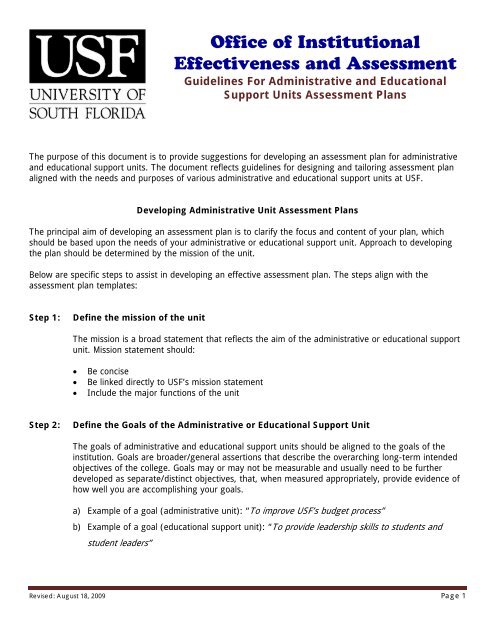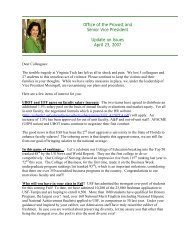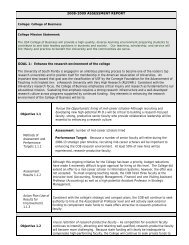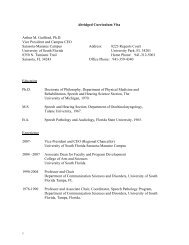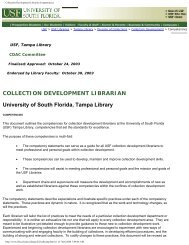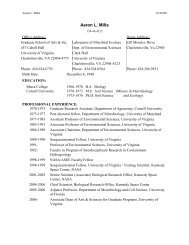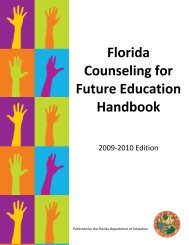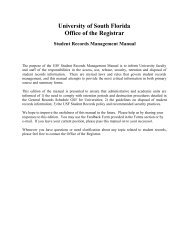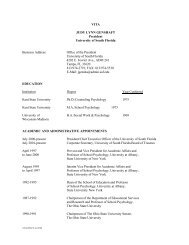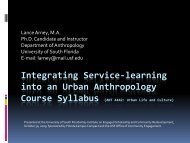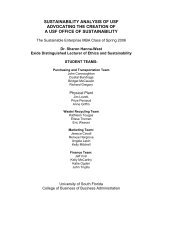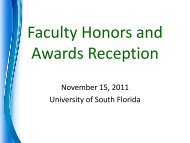Administrative and Educational Support Unit Assessment Guidelines
Administrative and Educational Support Unit Assessment Guidelines
Administrative and Educational Support Unit Assessment Guidelines
You also want an ePaper? Increase the reach of your titles
YUMPU automatically turns print PDFs into web optimized ePapers that Google loves.
Office of InstitutionalEffectiveness <strong>and</strong> <strong>Assessment</strong><strong>Guidelines</strong> For <strong>Administrative</strong> <strong>and</strong> <strong>Educational</strong><strong>Support</strong> <strong>Unit</strong>s <strong>Assessment</strong> PlansThe purpose of this document is to provide suggestions for developing an assessment plan for administrative<strong>and</strong> educational support units. The document reflects guidelines for designing <strong>and</strong> tailoring assessment planaligned with the needs <strong>and</strong> purposes of various administrative <strong>and</strong> educational support units at USF.Developing <strong>Administrative</strong> <strong>Unit</strong> <strong>Assessment</strong> PlansThe principal aim of developing an assessment plan is to clarify the focus <strong>and</strong> content of your plan, whichshould be based upon the needs of your administrative or educational support unit. Approach to developingthe plan should be determined by the mission of the unit.Below are specific steps to assist in developing an effective assessment plan. The steps align with theassessment plan templates:Step 1:Define the mission of the unitThe mission is a broad statement that reflects the aim of the administrative or educational supportunit. Mission statement should:Be conciseBe linked directly to USF’s mission statementInclude the major functions of the unitStep 2:Define the Goals of the <strong>Administrative</strong> or <strong>Educational</strong> <strong>Support</strong> <strong>Unit</strong>The goals of administrative <strong>and</strong> educational support units should be aligned to the goals of theinstitution. Goals are broader/general assertions that describe the overarching long-term intendedobjectives of the college. Goals may or may not be measurable <strong>and</strong> usually need to be furtherdeveloped as separate/distinct objectives, that, when measured appropriately, provide evidence ofhow well you are accomplishing your goals.a) Example of a goal (administrative unit): “To improve USF’s budget process”b) Example of a goal (educational support unit): “To provide leadership skills to students <strong>and</strong>student leaders”Revised: August 18, 2009 Page 1
Step 3:a) Define Intended Objectives (<strong>Administrative</strong> <strong>Unit</strong>s)Objectives are measurable statements that describe the expected or intended quality relative totimeliness, responsiveness, accuracy, etc. Objectives often describe how well a unit intends tofunction or improve its functioning or the services provided. The important question in this sectionis: “What is the office trying to accomplish?”Client satisfaction is the most common type of administrative outcome/objective. Less common,but equally acceptable administrative outcomes/objectives are those that focus on the ability ofclients once services have been provided (e.g., staff’s ability to process a requisition after traininghas been provided).<strong>Administrative</strong>-level objectives must be:Linked to the university goals <strong>and</strong> mission statementRealistic in terms of the resources <strong>and</strong> support currently available within the collegeMeasurable – feasible to collect accurate quantitative <strong>and</strong>/or qualitative data usable for makingimprovements to process or unitExample of administrative objective: “Exp<strong>and</strong> use of purchasing cards (P-Card) for commodities<strong>and</strong> services utilized by the university”b) Define Intended Learning Outcomes (<strong>Educational</strong> <strong>Support</strong> <strong>Unit</strong>s)Student learning outcomes (SLOs) are statements that target the intended knowledge, abilities,values <strong>and</strong> attitudes students are meant to be able to demonstrate after participating in a givenactivity <strong>and</strong>/or after using services within an educational support unit.Student learning outcomes must be specific to the unit <strong>and</strong> measurable.Example of a student learning outcome: “Students participating in Learning Communities willexpress higher levels of personal interaction <strong>and</strong> satisfaction with the learning environment in theresidence halls than other resident students”Step 4:State the Method of <strong>Assessment</strong> <strong>and</strong> Performance TargetsMethod of <strong>Assessment</strong> refers to the “measures” your unit intends to use to reach the objectives(e.g. surveys, focus groups). Description of your assessment method(s) should include baselinedata/information which focuses on “the current state of the college” regarding a given objectivewhereas “Performance Target” refers to “where the college would like to be”. The statement(s)should briefly state how you will define success based on the defined objectives.It is important that the methods chosen enable the unit to evaluate its effectiveness in terms ofservices offered. A primary objective of assessment is to illuminate strengths <strong>and</strong> weaknesses inyour unit that that can lead to improvement.Revised: August 18, 2009 Page 2
a) Examples of Methods of assessment <strong>and</strong> Performance Target (<strong>Administrative</strong> <strong>Unit</strong>s):i) “Comparison of this year’s spending with last year’s spending”ii) “Customer satisfaction survey will indicate that more than 80% (15% more than last year) ofrespondents are satisfied with our services”b) Examples of Methods of assessment <strong>and</strong> Performance Target (<strong>Educational</strong> <strong>Support</strong> <strong>Unit</strong>s):i) “Students participating in the EBI multiculturalism <strong>and</strong> diversity test will score a mean of 5.5 orabove on all questions.”ii) “At least 75% of students responding to the Tunnel of Oppression survey will indicate that theexperience changed their thinking about oppression.”Step 5:<strong>Assessment</strong> ResultsThis section, which forms the first part of the assessment report, requires actual data/informationbased on the previously stated objectives/outcomes, methods of assessment <strong>and</strong> performancetargets. The data gathered must be analyzed <strong>and</strong> formatted in a way that it provides usefulinformation for identifying strengths <strong>and</strong> weaknesses <strong>and</strong> improving processes <strong>and</strong> services.Step 6:Action Plan - Use of Results ImprovementThis section, commonly referred to as “closing the loop”, requires an action plan of the unit basedon the achieved results. <strong>Administrative</strong> <strong>and</strong> educational support units are required to reviewassessment results with a focus toward uncovering services or parts of services that need to beimproved. Since the express purpose of assessment is to use what is learned in the process toimprove performance of units, it is important that annual assessment report contain a description ofthe actions or “steps” that were taken in response to the assessment results to improve the unit’sservices (e.g., enhance services, add personnel, enhance technology, etc).Revised: August 18, 2009 Page 3


